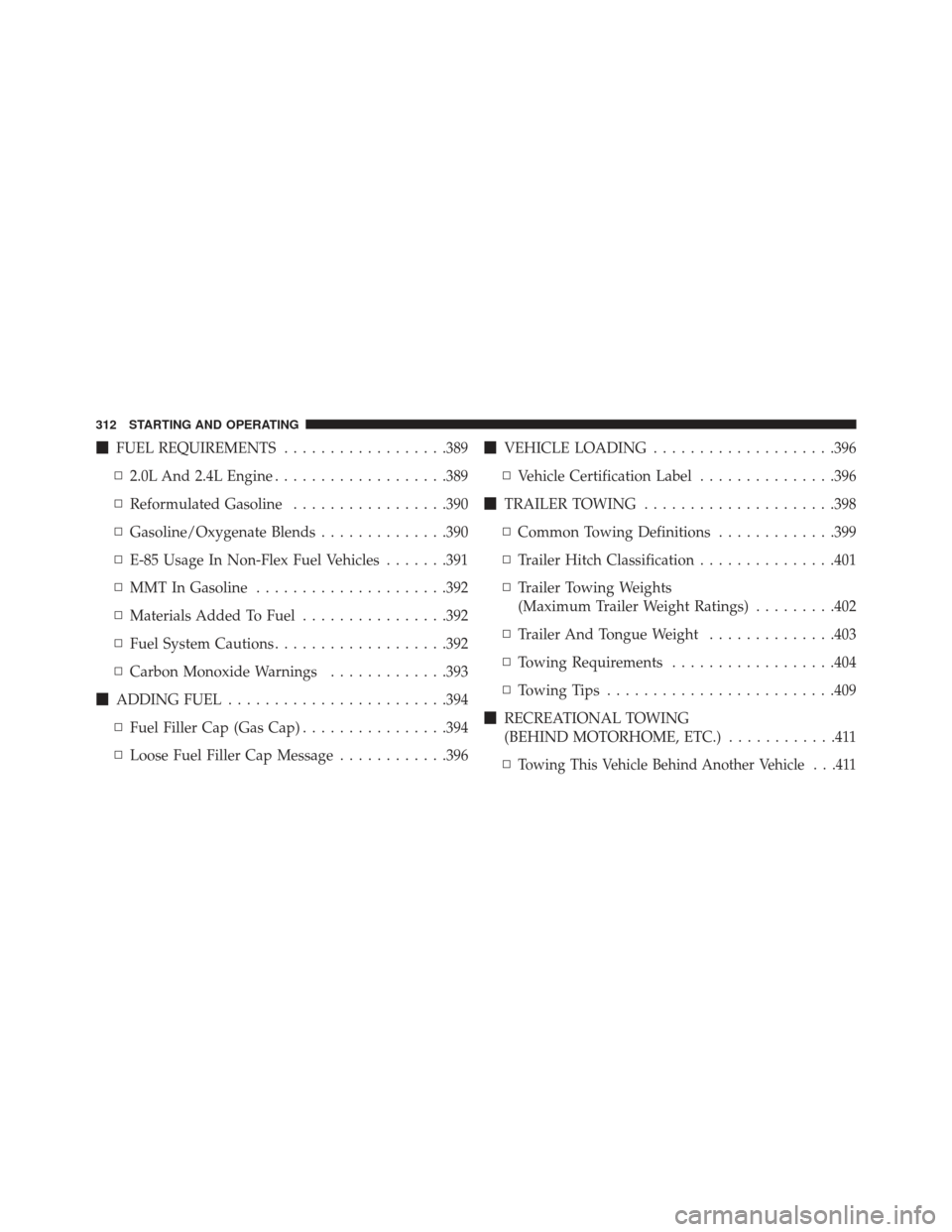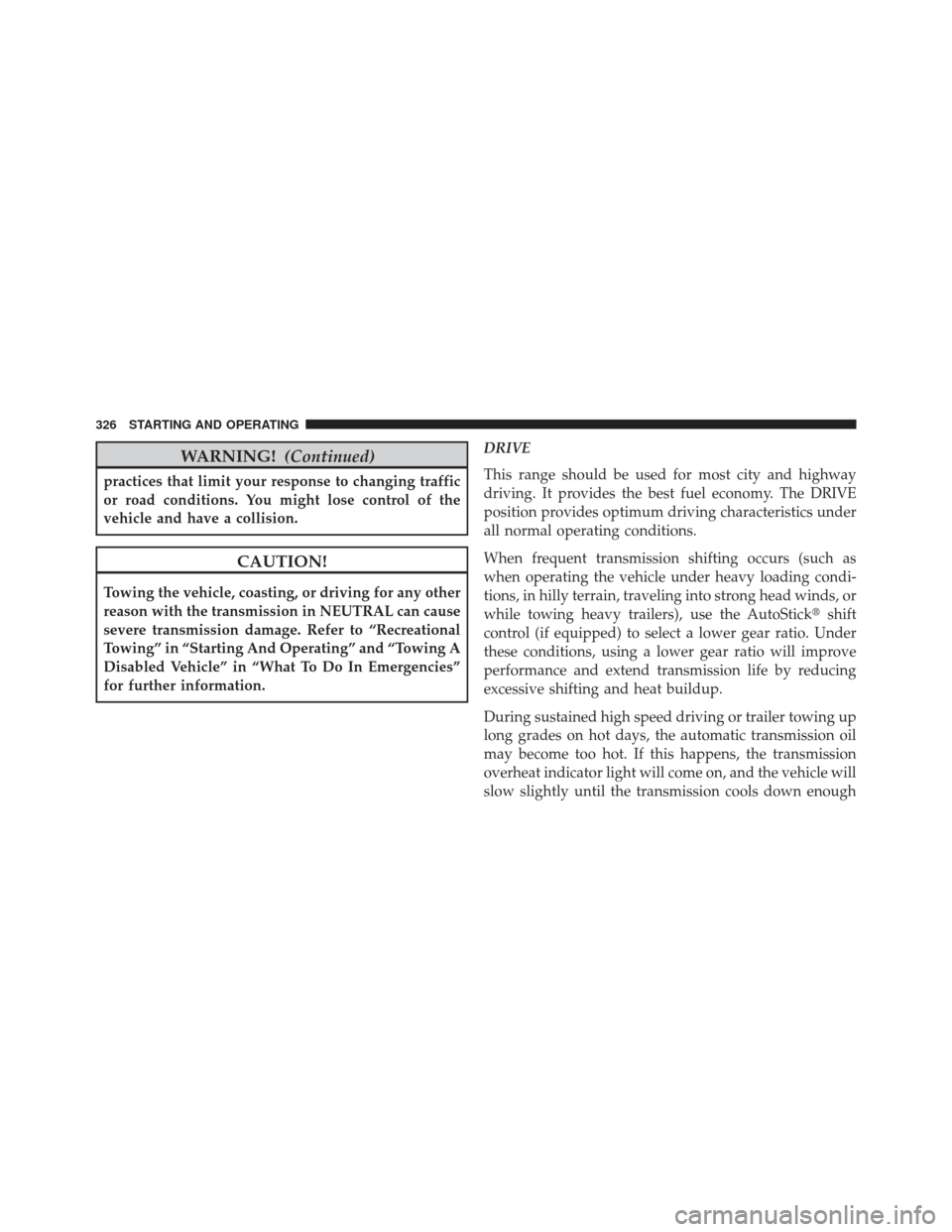Page 300 of 525

Bi-LevelAir is directed through the panel and floor outlets.
NOTE: For all settings, except full cold or full hot,
there is a difference in temperature between the upper
and lower outlets. The warmer air flows to the floor
outlets. This feature gives improved comfort during
sunny but cool conditions.
Floor
Air is directed through the floor outlets with a
small amount flowing through the defrost and
side window demist outlets.
Mix
Air is directed through the floor, defrost, and side
window demist outlets. This setting works best in
cold or snowy conditions that require extra heat to the
windshield. This setting is good for maintaining comfort
while reducing moisture on the windshield. Defrost
Air is directed through the windshield and side
window demist outlets. Use this mode with maxi-
mum blower and temperature settings for best wind-
shield and side window defrosting.
NOTE:
• The air conditioning compressor operates in Mix,
Defrost, or a blend of these modes, even if the Air
Conditioning (A/C) button is not pressed. This dehu-
midifies the air to help dry the windshield. To improve
fuel economy, use these modes only when necessary.
• For information on operating the Rear Defrost, refer
to “Rear Window Features” in “Understanding The
Features Of Your Vehicle”.
298 UNDERSTANDING YOUR INSTRUMENT PANEL
Page 314 of 525

�FUEL REQUIREMENTS ..................389
▫ 2.0L And 2.4L Engine ...................389
▫ Reformulated Gasoline .................390
▫ Gasoline/Oxygenate Blends ..............390
▫ E-85 Usage In Non-Flex Fuel Vehicles .......391
▫ MMT In Gasoline .....................392
▫ Materials Added To Fuel ................392
▫ Fuel System Cautions ...................392
▫ Carbon Monoxide Warnings .............393
� ADDING FUEL ....................... .394
▫ Fuel Filler Cap (Gas Cap) ................394
▫ Loose Fuel Filler Cap Message ............396�
VEHICLE LOADING ....................396
▫ Vehicle Certification Label ...............396
� TRAILER TOWING .....................398
▫ Common Towing Definitions .............399
▫ Trailer Hitch Classification ...............401
▫ Trailer Towing Weights
(Maximum Trailer Weight Ratings) .........402
▫ Trailer And Tongue Weight ..............403
▫ Towing Requirements ..................404
▫ Towing Tips ........................ .409
� RECREATIONAL TOWING
(BEHIND MOTORHOME, ETC.) ............411
▫
Towing This Vehicle Behind Another Vehicle . . .411
312 STARTING AND OPERATING
Page 316 of 525

Automatic Transmission – If Equipped
The shift lever must be in the PARK or NEUTRAL
position before you can start the engine. Apply the brakes
before shifting to any driving gear.
NOTE:You must press the brake pedal before shifting
out of PARK.
Tip Start
Do not press the accelerator. Turn the ignition switch to
the START position and release it as soon as the starter
engages. The starter motor will continue to run, and it
will disengage automatically when the engine is running.
If the engine fails to start, the starter will disengage
automatically in 10 seconds. If this occurs, turn the
ignition switch to the LOCK position, wait 10 to 15 sec-
onds, then repeat the “Normal Starting” procedure.
Normal Starting
Normal starting of either a cold or a warm engine does
not require pumping or pressing the accelerator pedal.
Simply turn the ignition switch to the START position
and release when the engine starts. If the engine fails to
start within 15 seconds, turn the ignition switch to the
OFF position, wait 10 to 15 seconds, then repeat the
“Normal Starting” procedure.
WARNING!
Do not attempt to push or tow your vehicle to get it
started. Vehicles equipped with an automatic trans-
mission cannot be started this way. Unburned fuel
could enter the catalytic converter and once the
engine has started, ignite and damage the converter
and vehicle. If the vehicle has a discharged battery,
booster cables may be used to obtain a start from
(Continued)
314 STARTING AND OPERATING
Page 317 of 525

WARNING!(Continued)
another vehicle. This type of start can be dangerous if
done improperly, so follow the procedure carefully.
Refer to “Jump Starting” in “What To Do In Emer-
gencies” for further information.
Extreme Cold Weather (Below –20°F Or �29°C)
To ensure reliable starting at these temperatures, use of
an externally powered electric engine block heater (avail-
able from your authorized dealer) is recommended.
If Engine Fails To Start
If the engine fails to start after you have followed the
“Normal Starting” and “Extreme Cold Weather” proce-
dures, it may be flooded. Push the accelerator pedal all
the way to the floor and hold it there. Crank the engine
for no more than 15 seconds. This should clear any excess
fuel in case the engine is flooded. Leave the ignition key in the ON position, release the accelerator pedal and
repeat the “Normal Starting” procedure.
WARNING!
Never pour fuel or other flammable liquid into the
throttle body air inlet opening in an attempt to start
the vehicle. This could result in flash fire causing
serious personal injury.
CAUTION!
To prevent damage to the starter, do not crank the
engine for more than 15 seconds at a time. Wait 10 to
15 seconds before trying again.
After Starting
The idle speed is controlled automatically and it will
decrease as the engine warms up.
5
STARTING AND OPERATING 315
Page 320 of 525
Recommended Shift Speeds
To use your manual transmission for optimal fuel
economy, it should be upshifted as listed in the following
table.
Manual Transmission Recommended Shift SpeedsUnits in mph (km/h)
Engine Size Accel-
eration Rate 1to2 2to3 3to4 4to5
All
Engines Accel 14
(23)23
(37) 29
(47) 45
(72)
Cruise 12 (19)18
(29) 25
(40) 32
(52)
Downshifting
Proper downshifting will improve fuel economy and
prolong engine life.
CAUTION!
If you skip more than one gear while downshifting
or downshift at too high a vehicle speed, you could
damage the engine, transmission, or clutch.
To maintain a safe speed and prolong brake life, shift
down to second or first gear when descending a steep
grade.
When turning a corner or driving up a steep grade,
downshift early so that the engine will not be overbur-
dened.
318 STARTING AND OPERATING
Page 328 of 525

WARNING!(Continued)
practices that limit your response to changing traffic
or road conditions. You might lose control of the
vehicle and have a collision.
CAUTION!
Towing the vehicle, coasting, or driving for any other
reason with the transmission in NEUTRAL can cause
severe transmission damage. Refer to “Recreational
Towing” in “Starting And Operating” and “Towing A
Disabled Vehicle” in “What To Do In Emergencies”
for further information. DRIVE
This range should be used for most city and highway
driving. It provides the best fuel economy. The DRIVE
position provides optimum driving characteristics under
all normal operating conditions.
When frequent transmission shifting occurs (such as
when operating the vehicle under heavy loading condi-
tions, in hilly terrain, traveling into strong head winds, or
while towing heavy trailers), use the AutoStick
�shift
control (if equipped) to select a lower gear ratio. Under
these conditions, using a lower gear ratio will improve
performance and extend transmission life by reducing
excessive shifting and heat buildup.
During sustained high speed driving or trailer towing up
long grades on hot days, the automatic transmission oil
may become too hot. If this happens, the transmission
overheat indicator light will come on, and the vehicle will
slow slightly until the transmission cools down enough
326 STARTING AND OPERATING
Page 333 of 525

When To Use Low (L Off-Road) With The 4WD
Lock Lever Engaged
When driving off-road, shift into low (L Off-Road) and
activate the 4WD LOCK. This will provide additional
traction and activates the numerous off-road features to
improve handling and control on slippery or difficult
terrain. Due to the sustained lower gearing, low (L Off-
Road) with 4WD LOCK engaged will allow the engine to
operate in a higher power range. This will allow you to
cross over obstacles and descend hills, with improved
control and less effort.
NOTE:For maximum off-road performance, premium
fuel is recommended. While the vehicle will operate on
regular fuel when in L Off-Road mode, the engine has
been calibrated for maximum performance using pre-
mium fuel.
Driving In Snow, Mud And Sand
There is a drastic reduction in traction when driving in
snow, mud or sand. The vehicle will be less responsive to
steering, acceleration and braking inputs. Therefore, you
should accelerate slowly, leave greater stopping distances
and avoid abrupt vehicle maneuvers. You want to keep a
slow constant steady pace. The key is to maintain the
vehicle’s momentum.
Snow
In heavy snow or for additional control and traction at
slower speeds, activate the 4WD LOCK and shift the
transaxle to low (L Off-Road) if necessary. Do not shift to a
lower gear than necessary to maintain headway. Over-
revving the engine can spin the wheels and traction will be
lost. If you start to slow to a stop, try turning your steering
wheel no more than a 1/4 turn quickly back and forth,
while still applying throttle. This will allow the tires to get
a fresh �bite�and help maintain your momentum.
5
STARTING AND OPERATING 331
Page 340 of 525

•Check threaded fasteners for looseness, particularly on
the chassis, drivetrain components, steering, and sus-
pension. Retighten them, if required, and torque to the
values specified in the Service Manual.
• Check for accumulations of plants or brush. These
things could be a fire hazard. They might hide damage
to fuel lines, brake hoses, axle pinion seals, and
propeller shafts.
• After extended operation in mud, sand, water, or
similar dirty conditions, have the radiator, fan, brake
rotors, wheels, brake linings, and axle yokes inspected
and cleaned as soon as possible.
WARNING!
Abrasive material in any part of the brakes may cause
excessive wear or unpredictable braking. You might
(Continued)
WARNING! (Continued)
not have full braking power when you need it to
prevent a collision. If you have been operating your
vehicle in dirty conditions, get your brakes checked
and cleaned as necessary.
• If you experience unusual vibration after driving in
mud, slush or similar conditions, check the wheels for
impacted material. Impacted material can cause a
wheel imbalance and freeing the wheels of it will
correct the situation.
POWER STEERING
The standard power steering system will give you good
vehicle response and increased ease of maneuverability
in tight spaces. The system will provide mechanical
steering capability if power assist is lost.
338 STARTING AND OPERATING